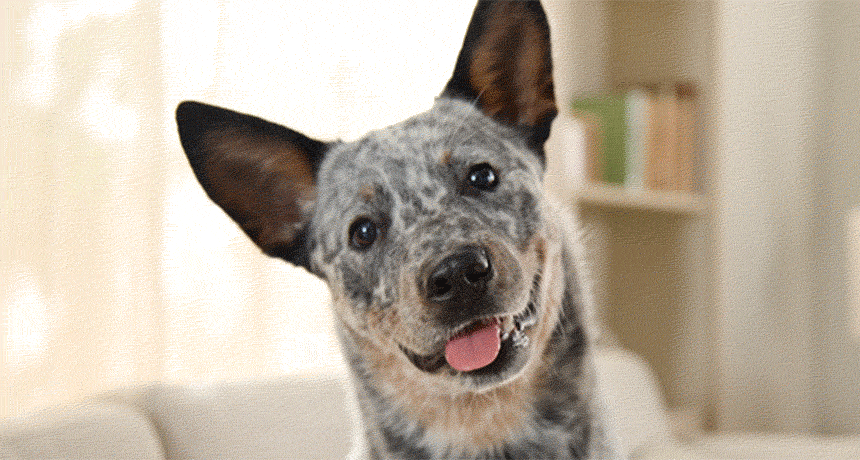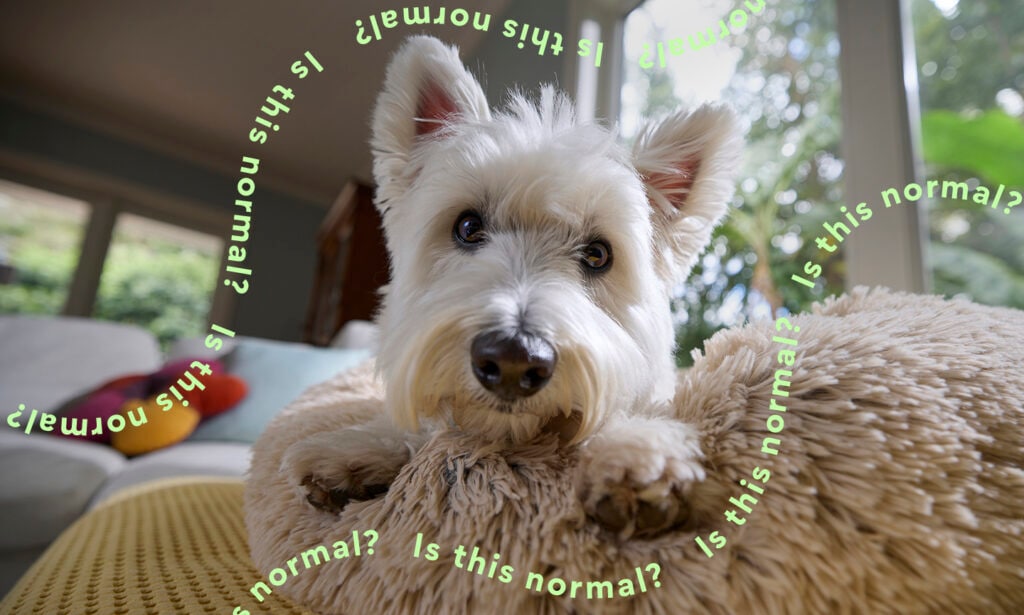Q:Sometimes, I can sense that my dog is just, like, looking at me—intensely. Why does my dog stare at me? Is that normal?
A: Yes, it’s normal for dogs to stare at you! They probably just want something from you—a meal, a walk, or maybe a scratch behind the ears—and are waiting for you to notice.
You seem to always feel it. You’ll be half-watching some Netflix series when you have the unshakeable sensation that you’re being watched. And, sure enough, you look over and your dog is sitting there, focusing their attention— and both of their eyeballs—right on you. So what gives?
In short, dogs stare for a number of reasons, but mainly, it’s a way for them to communicate with you.
In This Guide:
Why Do Dogs Stare at You? 3 Possible Reasons

1. They Want Something From You
Dogs use their behavior, like staring, to get the things they want, says dog trainer and animal behaviorist Melanie Cerone, PhD, BCBA, CPDT-KA. That could include:
- Food
- Attention
- Petting
- A game of fetch
“Dogs stare at us because we, their caregivers, reinforce them for doing so in a variety of ways,” says Cerone.
Basically, our dogs know that if they just look at us, we’ll give them whatever they want.
For example, if dogs watch us while we’re eating, we might give them a bite of whatever we’re having. Or if they look at us while we’re working or watching TV, we might be prompted to pet them, talk to them, or take them out for a walk.
“If you think about it, we are the source of all good things for our dogs,” Cerone explains. “They depend on us for all their food; daily enrichment, such as walks, play, and training; attention, including petting and praise; and comfort when they are fearful or anxious.
“Staring can serve a communication function for dogs,” she continues. “It’s a way for them to let us know that they need or want one of these good things.”
2. It's a Look of Love
Do dogs ever stare at us just because they like us a lot? Actually, yes.
“Sometimes when our dogs stare at us, it encourages us to provide them with attention, which is also a major reward,” says Aubrey Sperry, CDBC, CPDT-KA, owner and head trainer at Sit Pretty Dog Training in Massachusetts.
That act helps to promote social bonding.
“Research has been done that indicates both humans and dogs experience an increase in [the ‘feel good’ hormone] oxytocin after staring into each other’s eyes,” Sperry says.
So it goes something like this: The dog stares, we look back, reward them with our love and affection, the bond between dog and human grows. Rinse and repeat. How sweet!
3. It's a Sign of Aggression
While dog stares are often loving or solicitous, they can sometimes signify more negative emotions.
Staring or holding eye contact may indicate that a dog is fearful, anxious, or uncomfortable in some way, Cerone explains.
If a dog is staring at you while guarding their food bowl or a favorite toy, then both Cerone and Sperry say that can be a signal to back off. (This behavior is known as “resource guarding.”)
The same goes for a “hard stare” that accompanies a rigid posture or stiffened tail.
“This behavior precedes more intense behaviors such as growling, lunging, and biting,” Sperry adds.
This may be more common with houseguests than the pet parents themselves, because some dogs are wary of strangers.
“Typically, I see this with strangers approaching dogs more than with pet dogs at home interacting with their owners,” Sperry says.
It’s also not a good idea for us to stare at dogs we don’t know.
“Dogs can perceive direct eye contact from unfamiliar people as a threatening gesture,” Cerone says. “So when meeting a dog for the first time, it’s typically best to avoid making direct eye contact with, staring at, or leaning over the dog, particularly if the dog is fearful or anxious of new people.”
How To Figure Out Why a Dog Is Staring at You
You don’t need some kind of Dog-to-English dictionary for this: You just need to use some context clues.
By considering what you’re doing and when you’re doing it, you can probably figure out what your dog is trying to communicate with their big, expressive eyes.
Take this scenario from Cerone as an example:
You’re working at your computer only to look up and find your dog staring at you while panting and wagging their tail.
You wonder what they want when you happen to glance at the clock and notice that it’s past their dinnertime.
You jump up from your computer, apologize, and then you both run to the kitchen so you can prepare their dinner.
Their tactic of staring worked and prompted the desired outcome: food.
The next time you work past your dog’s dinner hour, what do you think they might do?
Although you might be able to decipher your own dog’s behaviors, it can sometimes be trickier to understand what an unfamiliar dog is trying to communicate. In those times, it may be best to avoid returning their eye contact and to assess what their body language—below their eyeballs—is saying. Are they showing signs of fear or aggression?
How To Respond to a Dog Staring at You
What if your dog is staring at you even after they’ve been fed, walked, and belly-rubbed? Is there a way to get them to maybe … not do that?
You can discourage staring by helping condition them to relax in another space, says Perry.
“This can be accomplished by rewarding them for an alternative behavior like lying down on a nearby dog bed or other comfy spot,” she explains. “You can also choose to train this behavior prior to [the staring], by cueing them to go to their comfy spot at a time they may typically stare at you.”
So if our dogs stare at us to get what they want, what would happen if we stared at them first? Probably just a few tail wags. Unfortunately, they’re not going to be prompted to fix your dinner.
FAQs About Dog Staring
Q:What does it mean when a dog stares at you without blinking?
A:If your dog isn’t blink, it means they’re very focused on you and whatever you’re doing, says Wailani Sung, DVM, DACVB, senior director of animal admissions and well-being at Joybound People and Pets in Walnut Creek, California.
- A soft stare with ears pulled slightly to the side may be just a sign that they’re interested in what you’re doing and want to watch you, Dr. Sung says.
- A more intense stare can occur if you’re standing near a treat cabinet or their leash. They may be more alert in case it’s time for treats or a walk around the block.
- A hard stare with tense body language may indicate they’re worried about what you’re doing, like if you move too close to an item they’re guarding, she says.
Q:Should I let my dog stare at me?
A:A dog staring is not necessarily a negative behavior, depending on the context, says Dr. Sung.
If you’re bothered by your dog staring at you, redirect their dog focus on something more productive, like working on a food puzzle toy, she adds.
“The puzzle toy provides both a physical and mental outlet for your dog, and they can focus on a more productive behavior that earns them goodies,” Dr. Sung explains.
Q:Why does my dog stare at me and look sad?
A:When a dog pulls their ears back when you look at them, they’re showing deferential signaling—in other words, it looks like they’re sad, explains Dr. Sung.
They may have learned to exhibit this sad-eye stare because it always gets your attention, she adds. You may then feel obliged to give your dog attention or engage them in an activity to ease your guilt of feeling like you made your dog sad.
Q:Why does my dog follow me everywhere and stare at me?
A:This is one way a dog can ask for attention without being physically demanding, like jumping on you, Dr. Sung says.
If your dog follows your every move and stares at you, you likely can’t help but look back at them. And your dog may be eagerly following you around for a few possible reasons:
- They want to play. They’re hoping you’ll pet or play with them, give them a puzzle toy or long-lasting treat, or take them on a walk.
- They’re curious and want to know what you’re doing. For example, you may be cleaning or putting away laundry, and your pup is right by your side, watching you and checking your work.
- They want to come with you. Some dogs may follow their pet parents around when they may be preparing to leave. They’re right by your side in case they get to go along too.
- They’re anxious. For dogs with separation disorder, they’re watching to make sure you’re not preparing to leave.
More about dog behavior:
Share:














